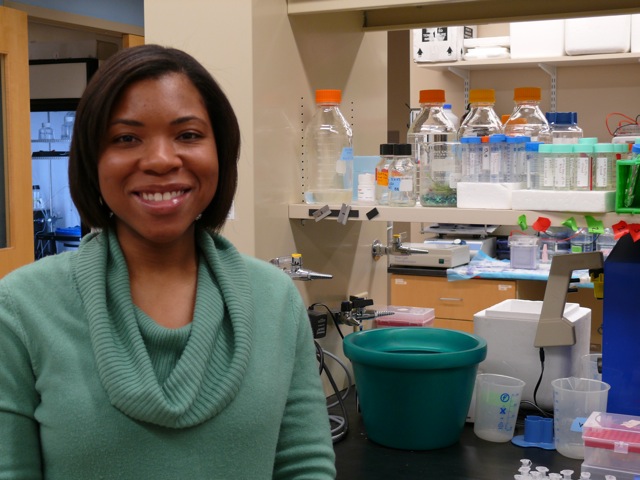Researchers: Sleeper-Cell Bacteria Elude Antibiotics

Breann Brown of Brown University, along with other researchers including Thomas Wood, Professor of Chemical Engineering & Biology at Texas A&M, worked on a study that found that bacterial cells possess the capacity to go dormant when they encounter stressor including antiobiotics. Antibiotics canÕt lock on to the bacterial cells in this state. When the stressor is removed, the bacterial cells emerge from dormancy. Photo courtesy of Rebecca Page, Brown University
By James Jeffrey
For Reporting Texas and the Austin American-Statesman
Like super agent Jason Bourne, bacterial cells possess the capacity to go off the grid, hiding from antibiotics until danger has passed and then reemerging to attack our immune system, according to scientists at Texas A&M and Brown universities.
They say their new research helps explain how some bacteria go to “sleep” and provides crucial information that could help maintain the effectiveness of antibiotics.
After all, no antibiotic can work if a dormant bacterium is no longer doing what the antibiotic is trying to prevent.
“For many people when they have operations in a hospital, the bacteria do not respond to the antibiotics, and people die,” said Thomas Wood, a professor at Texas A&M. “I think it’s an extraordinarily important problem.”
Wood conducted the research at A&M with his postdoctoral student Xiaoxue Wang in the department of chemical engineering, along with professors in the Biology and Entomology departments. Scientists from Brown University also played a key part.
The research, described in the online April edition of “Nature Chemical Biology,” revealed how certain bacteria go dormant in the presence of external stressors, which range from ultraviolet light to antibiotics.
“They’re always hounded with these different stresses from the environment; life is stress for a bacterium,” Wood said.
Ironically, bacteria utilize their own version of antibiotics to protect themselves — using antitoxins to counter toxins present within their cell walls.
But when a greater threat such as antibiotic is detected, these bacteria will manipulate their system and turn off the antitoxins, allowing the toxins to degrade them to the point the bacteria shut down.
The result is “like shooting yourself in the foot to avoid going to war,” Wood said. “You want to damage yourself, but actually wind up living, which is really quite a concept.”
Researchers have long understood how bacteria mutate to outmaneuver antibiotics, Wood said. But his research group has focused on a lesser-known, alternative method of survival.
“With a specific mutation, you’d be able to gain resistance to a specific antibiotic,” he said. “Whereas going to sleep, you gain resistance to perhaps all antibodies.”
The battlefield analogy — with its violence, stealth and defense mechanisms — is an apt one when it comes to bacteria. They have strategies, battle plans and enemies, and their main enemies are viruses.
These enter a bacterium cell and hide in its chromosome — where genetic information is contained — before jumping out, reproducing and killing lots more bacteria. But occasionally, a hiding virus gets mutated before it can get out, as mutations are always occurring in bacteria, Wood said.
“Here’s the beauty of it,” Woods said. “Now the bacterium has gained the genes and tools of its worst enemy, and it can use them for itself.”
The new research focused on the interplay of three components in the bacteria studied: toxins, messenger RNA and proteins.
The toxins degrade messenger RNA, which is an intermediary between information stored in DNA — the genetic blueprint all organisms possess — and the formation of proteins, which are crucial for all cell-based organisms: bacteria and humans.
“It’s proteins that convert the energies from foods to the energy to walk, and it’s also the proteins that make the structural components that allow you to walk,” Wood said.
Specifically the scientists found when their bacterial cells encountered stress the cells initiated a process leading to the degrading of an antitoxin called MqsA. This allowed a toxin called MqsR to attack the cell’s messenger RNA, thereby degrading the protein-manufacturing factory and causing the bacterium cell to go dormant because of insufficient proteins.
An antibiotic, like a heat-seeking missile finding no heat signature, can’t lock on to a cell in this state. Once the stressor goes, the cell comes back online and resumes normal activities, Wood said.
Understanding the structure of the elements involved at the atomic level was crucial to understand how they functioned.
This was where Brown University came in — providing the details of cell structure and enabling A&M to utilize that knowledge in understanding the functions.
“It’s really the two labs together that can actually build the complete story,” said Rebecca Page, an assistant professor, who along with Breann Brown and Wolfgang Peti conducted research in Brown’s Department of Molecular Biology, Cell Biology and Biochemistry.
Page said the research has strategic significance for dealing with bacteria.
“Since toxins and antitoxin systems are present really throughout almost all the bacterial kingdom, anything that we learn here will be applicable to other bacteria.”
Researchers have worked two years on their sleeper cell theory. In the next phase, they hope to manipulate bacteria — preventing them from going dormant, so antibiotics can lock on to them.
The goal: making antibiotics more effective.